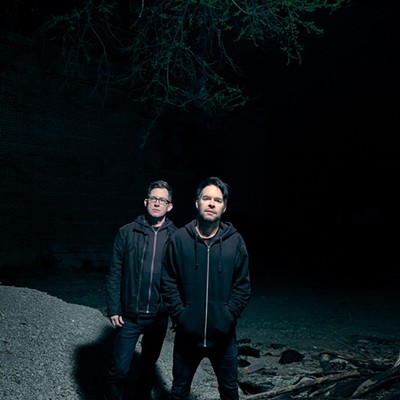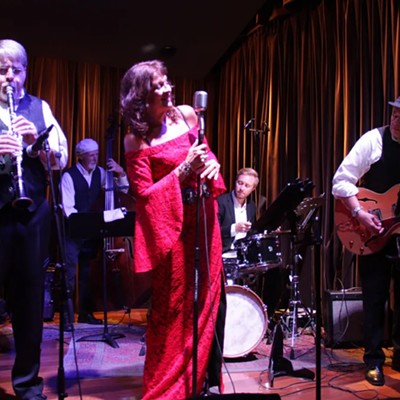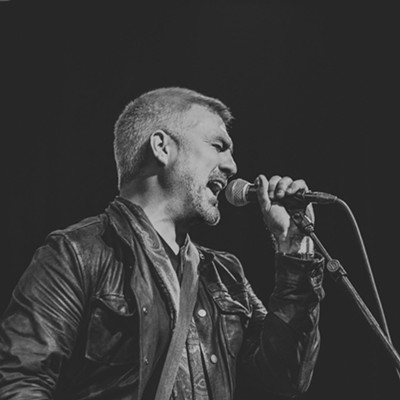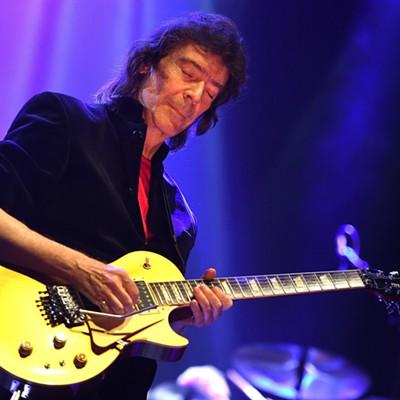In the intervening period, Tucson and the rest of the country have changed a great deal. So has Yo La Tengo. Now, as they've aged (er, become more mature), they're probably a bit less reluctant to accept their mantle--The Elder Statespeople of Independent Rock Music. Sonic Youth, Shmonic Youth.
Of course, YLT never asked for any such appellation; it simply fits them. Having formed in 1984, the band celebrates its 20th anniversary this year. While there are other groups of note (see Sonic Youth, supra) that have been around as long or longer, few have a recorded output of such consistent quality; Yo La Tengo has resisted the vagaries of fashionability for so long that they've become a genre unto themselves.
This is not to say their music is "samey." On the contrary; it's YLT's varied approach, with core competencies in songwriting and the selection of songs to cover, that resonates most with their fans. Depending on the record, Yo La Tengo are a blissrock band (1997's I Can Hear The Heart Beating as One) with much in common with the aforementioned Sonic Youth or My Bloody Valentine; or they're an indie pop outfit covering the Beach Boys (Little Honda EP, 1998) or Sky Saxon (1995's Camp Yo La Tengo EP). Lately, they've veered in a quieter direction, on 2000's And Then Nothing Turned Itself Inside Out and their latest full-length, the jazz-influenced Summer Sun, released last year on longtime label Matador.
However, these general tendencies are far from aesthetic pigeonholes. Summer Sun, for instance, features the comical (they're often comical, if obscure) "Summer of the Shark" and a Big Star cover with steel guitar courtesy of Calexico's Paul Niehaus ("Take Care"), plus tender, breathy pop alongside the rest of the album's quasi-lounge stylings.
This admirable trait results from Yo La Tengo's recording approach as much as anything. They are firm believers in the "jam" method, doing much of their recording essentially live, as if rehearsing. That, alongside their obsessive knowledge of music, makes them dynamic. Frankly, it's intimidating to write about such a well-versed band. Ira Kaplan, YLT's principal guitar player, was formerly a music critic (and probably would be appalled at the run-on sentences herein), and he shares a record-collecting fetish with his bandmates--wife and drummer Georgia Hubley and bassman James McNew.
According to their longtime companion of a producer, Roger Moutenot, interviewed in Tape Op magazine, "Yo La Tengo is a really tense band ... they work off that. If it's not tense, then there's something wrong." He describes a recording scenario wherein the group performs in one room, with different instrumental setups in different parts of the room. One of them will play a part on a vibraphone, say, and then get up and walk over to where a keyboard sits to play a different part in the same song as it's being recorded. This unorthodox methodology results in a lot of bleed--sounds crossing over onto different tracks of the recording, which, to most producers, is heretical--which Moutenot was taught to appreciate by T-Bone Burnett. "I love bleed," the producer says in the Tape Op piece.
Yo La Tengo infrequently recruits outside players, usually preferring to take their own stabs at the instrumentation, even if it's beyond their proficiencies. For Summer Sun (and a separate single, "Nuclear War," which features a variety of versions of Sun Ra's brilliant genre-smashing opus), Yo La Tengo corralled some of the best free jazz musicians on the planet, including the extraordinary bassist William Parker, his frequent collaborator Roy Campbell Jr. and the saxophonist Daniel Carter, among others. Kaplan makes it clear in an e-mail exchange with Dave Heaton of Erasingclouds.com that YLT wasn't striving for a particular effect in inviting such musicians to record with them. Rather, their impetus was to see what would happen. And, of course, the improvisational skills of premier free jazz musicians are quite conducive to the "Yo La Tengo way," as previously described.
Do not get the impression that Summer Sun is all about jazz, however. It's perhaps YLT's mellowest, prettiest record to date.
"We've always been drawn to quieter music," said Kaplan about the different sonic trajectory they've been on since I Can Hear The Heart Beating As One. He continues "... but we felt we had to balance it with louder material," in the August 2003 Guitar Player. While very little of Summer Sun would fall under the rubric of "louder," "Nuclear War" (from late 2002) is pretty rousing, as is much of Today is The Day, an EP released in October. Thus, the balance is struck.
In the immediate future, Yo La Tengo are wending their way down the West Coast, having kicked off their current tour in Vancouver, of all the places these Hobokenites could have chosen. After their June 2 appearance at Tucson's City Limits nightclub (not quite Austin City Limits, but hey), YLT heads to Texas and points east, culminating in an appearance at "Coachella of the East," aka the Bonnaroo festival in Tennessee. There, they'll play alongside an absolute wealth of talent, including our own Calexico. Perhaps they will then be given their Elder Statesperson robes.
A chance to see Yo La Tengo is exceedingly rare in Tucson, so you're advised to not miss it. It could be another nine years before they return.







